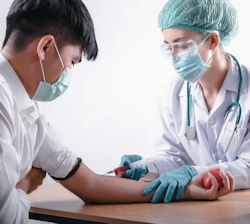PPE and the Bloodborne Pathogens Standard
PPE is required by the Bloodborne Pathogens Standard if exposure to blood and other potentially infectious materials (OPIM) is anticipated and where occupational exposure remains, after implementing engineering and work practice controls.
PPE can provide some protection from infectious materials as a barrier to protect skin and mucous membranes from contact with blood and other potentially infectious materials. 29 CFR 1910.1030(d)(2)(i)
Appropriate PPE must be provided by the employer, cleaned and laundered and disposed of, at no cost to the employee, in appropriate sizes and used by personnel if blood exposure is anticipated. PPE includes gloves, gowns, laboratory coats, masks, face shields, eye protection, mouthpieces, resuscitation bags, pocket masks, or other ventilation devices. 29 CFR 1910.1030(d)(3)(i)
- Employees must wear gloves when hand contact with blood, mucous membranes, OPIM, or non-intact skin is anticipated, when performing vascular access procedures, or when handling contaminated items or surfaces. 29 CFR 1910.1030(d)(3)(ix)
- Employees must wash hands immediately or as soon as feasible after removing gloves or other PPE. 29 CFR1910.1030(d)(2)(v)
- The employer shall ensure that employees who have contact with contaminated laundry wear protective gloves and other appropriate personal protective equipment. 29 CFR 1910.1030(d)(4)(iv)(B)
- PPE will be considered "appropriate" only if it does not permit blood or other potentially infectious materials to pass through to or reach the employee's work clothes, street clothes, undergarments, skin, eyes, mouth, or other mucous membranes under normal conditions of use and for the duration of time which the protective equipment will be used. 29 CFR 1910.1030(d)(3)(i)
Knowledge Check Choose the best answer for the question.
1-3. According to OSHA, when should healthcare workers wear gloves?
You forgot to answer the question!

